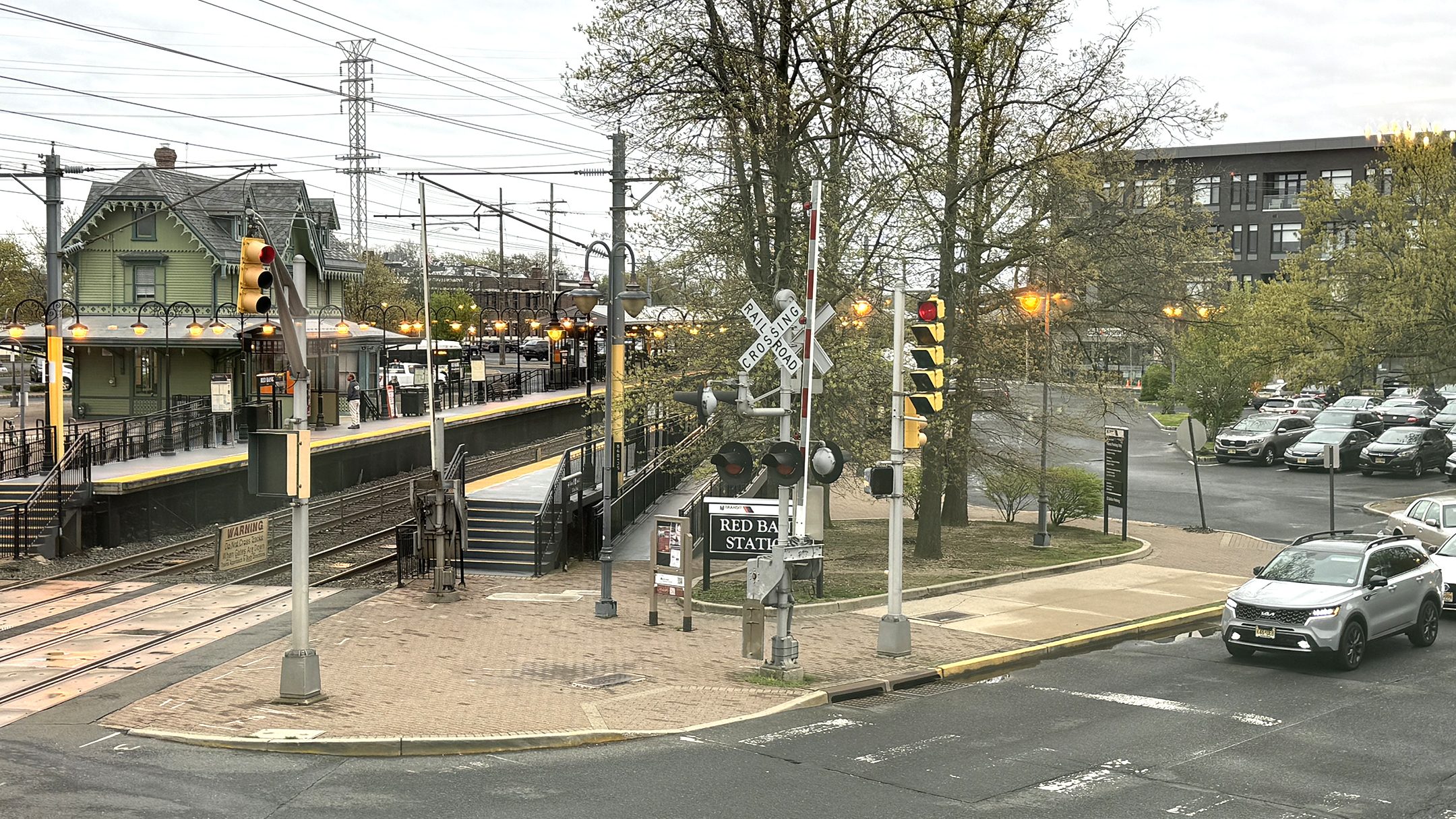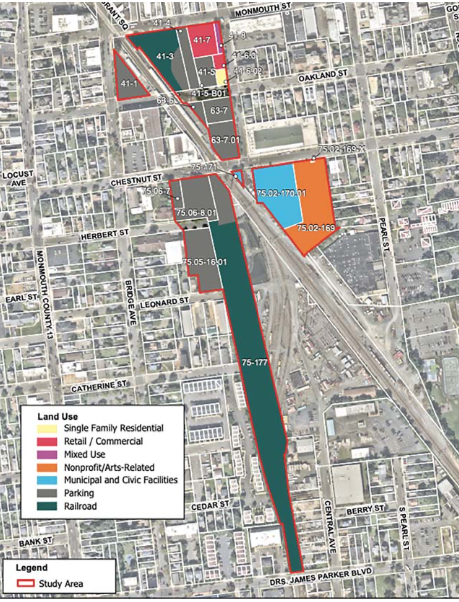
By Sunayana Prabhu
RED BANK – The borough’s transit village plan, slowed due to the pandemic, is back on track as the Red Bank Planning Board unanimously voted to approve and advance a redevelopment study report to the governing body. The study identifies specific parcels around the train station for redevelopment and is a vital step toward the borough council’s initiative to transform the area into a thriving transit village.
The borough applied for Transit Village designation in 2019, but the process lagged during the pandemic. In December 2023, the council directed the planning board to conduct a preliminary investigation to determine if certain properties around the train station constitute a “non-condemnation area in need of redevelopment.” The planning board hired BFJ Planning to complete the study, which was presented at the board’s regular meeting April 10.
“There is no eminent domain contemplated with this redevelopment study,” said Susan Favate, principal of BFJ Planning (the consultation agency also drafted the borough’s Master Plan) before presenting the report during the public hearing, allaying some fears.The entire study area, approximately 13 acres, incorporates parcels on either side of the railroad tracks, generally between Monmouth Street to the north and Drs. James Parker Boulevard to the south, including the east-west cross streets of Oakland, Chestnut, Herbert, Leonard and Tilton Avenue. The parcels largely comprise parking lots, infrastructure serving the commuter train station and adjacent rail yard, and the borough’s Department of Public Works (DPW) facilities. In addition, it also covers several commercial buildings and associated parking lots.
Property ownership in the study is a mix of public, private and nonprofit, but all of the properties are collectively held by just five entities: NJ Transit owns 8.42 acres, Denholtz Properties owns 1.73 acres, the Borough of Red Bank owns 1.19 acres, Count Basie Theatre Inc., owns 1.52 acres and KLE Properties LLC owns 0.09 acres. Denholtz Properties is also listed online as NJ Transit’s development partner.

The total assessed value of all the properties in the study “is about $13.5 million,” said Favate; however, the most recent tax year revenue collectively “was only about $110,000.”
“So, it is not generating a lot of tax because of the nature of the ownership and the use,” she said.
The scope of Favate’s investigations included a land use review, an assessment of property and building conditions, occupancy and ownership status, a review of tax data and aerial photos, and a review of the borough’s zoning ordinance, zoning map and 2023 Master Plan.
According to the report, the entire study area met the redevelopment designation criteria except one parcel – Block 41, Lot 8, currently home to Juanito’s restaurant.
Favate noted that most of the study area is largely “underutilized” parking areas with impervious surfaces. Most of the buildings cited in the report are in “fairly good condition,” with the exception of the DPW building. Favate said the trailers on site and the buildings are deteriorated, reporting an overall “lack of functionality in a tight space.” She also noted the DPW site is an “environmentally contaminated site. It’s a Brownfield. It’s being monitored on a regular basis by the state.”
The study also concluded that the Count Basie site is susceptible to stormwater flooding.
The mix of zones around the train station currently allows for a range of uses, including single-family residences, mixed-use developments, multifamily dwellings, offices, supermarkets, art studios, banks and theaters.
Favate noted “inconsistencies” in terms of pedestrian sidewalks and bike infrastructure.
“I don’t see any places over there that’s blighted,” with the exception of the DPW building, said resident Dan Riordan, objecting to the redevelopment designation during the public comment session. “It’s an area that could be redeveloped without having to go through the process of creating redevelopment,” he said. Riordan argued with the board that the “only reason to declare an area blighted is to take it by eminent domain or give somebody a 30-year tax break.”
However, borough attorney Marc Leckstein countered Riordan’s argument, telling him those options are “not within the power of this board.” Leckstein said the borough council has the final say in determining the redevelopment designation, not the planning board. “This board does not play any role whatsoever in giving a PILOT (payment in lieu of taxes), which is what you’re referring to. We have nothing to do with that.”
Leckstein explained that the planning board’s only responsibility is to determine, based on the study report, whether the areas meet the specific criteria set forth in the redevelopment law.
Resident Mary-Ellen Mess said she was “intrigued by the idea that the redevelopment designation actually gives the borough more control over what is actually built there in terms of design, zoning, and so forth.” However, Mess said her “major concern” was the borough “losing the ethnic and economic diversity” due to “undersized high density” development. Mess asked Favate if the borough can set aside “40% affordable housing” with the redevelopment area.
Planning board chair Dan Mancuso said, “The only way someone’s going to give us 40% of affordable housing is that they want more density.” He also noted that is not something that can be determined at this phase.
Anna Torres, the daughter of the owner of Juanito’s restaurant, asked the board if the study will affect their property. Leckstein confirmed that the study would not impact Juanito’s. Mancuso suggested Torres would have to reach out to the borough council if any redevelopment was needed, but “you’ve got a pretty good thing going there. I wouldn’t mess with it,” he said.
Torres agreed. Juanito’s has been a fixture on Monmouth Street for over three decades.
If the borough council agrees with the planning board’s recommendation, it is expected to authorize another resolution to direct the planning board to prepare a redevelopment plan in collaboration with the community, the next major phase in the making of a transit village.
“The redevelopment plan gets very specific on the land uses and the particular building requirements, site requirements, setbacks, coverage. All of the things that zoning typically controls are laid out in detail in the redevelopment plan,” said Favate.
The report can be reviewed in person from 9 a.m. to 4 p.m. Monday through Friday at the Planning and Zoning Office, 90 Monmouth St., 3rd Floor, Red Bank.
The article originally appeared in the April 18 – April 24, 2024 print edition of The Two River Times.














